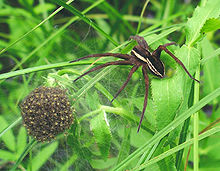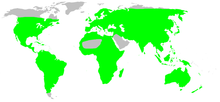| Nursery web spiders Temporal range:
| |
|---|---|

| |
| Nilus albocinctus, female Sabah, Borneo | |

| |
| Dolomedes fimbriatus with its nursery of babies | |
| Scientific classification | |
| Domain: | Eukaryota |
| Kingdom: | Animalia |
| Phylum: | Arthropoda |
| Subphylum: | Chelicerata |
| Class: | Arachnida |
| Order: | Araneae |
| Infraorder: | Araneomorphae |
| Family: | Pisauridae Simon, 1890 |
| Diversity | |
| 51 genera, 508 species | |

| |
Nursery web spiders (Pisauridae) are a family of araneomorph spiders first described by Eugène Simon in 1890.[1] Females of the family are known for building special nursery webs. When their eggs are about to hatch, a female spider builds a tent-like web, places her egg sac inside, and stands guard outside, hence the family's common name. Like wolf spiders, however, nursery web spiders are roaming hunters that do not use webs for catching prey.
Species occur throughout the world except for extremely dry or cold environments, and are common just about everywhere. Many can walk on the surface of still bodies of water and may even dive beneath the surface temporarily to escape enemies. They can jump a distance of 5 to 6 inches (130 to 150 mm), but they have trouble climbing extremely smooth surfaces such as glass.
The name "nursery web spider" is especially given to the European species Pisaura mirabilis, but this family also includes fishing spiders and raft spiders. Adult female specimens may reach up to 15 mm in length, excluding legs. The legs of the male are longer in relation to body size than those of the female.[2]
The female spider sometimes attempts to eat the male after mating. The male, to reduce the risk of this, often presents the female with a gift such as a fly when approaching in the hope that this will satisfy her hunger. Sometimes, this gift is a fake present intended to fool the female.[3] Males may wrap the fake gift in silk, to deceive the female to mate. Females can detect the fake gift and terminate mating, negating the male's deception in not giving a real gift.[4]
Nursery web spiders resemble wolf spiders (Lycosidae) except for some key differences. The posterior lateral eyes of wolf spiders are relatively far back and point sideways. In nursery web spiders, the posterior lateral eyes are closer to the posterior median eyes.[5] Also, female nursery web spiders carry their egg sacs with their chelicerae instead of attaching them to their spinnerets as wolf spiders do.[6]
- ^ Simon, E. (1890). Etudes arachnologiques.
- ^ Anderson, Alissa G.; Hebets, Eileen A. (2016). "Benefits of size dimorphism and copulatory silk wrapping in the sexually cannibalistic nursery web spider, Pisaurina mira". Biology Letters. 12 (2): 20150957. doi:10.1098/rsbl.2015.0957. PMC 4780555. PMID 26911340.
- ^ Male Spiders Scam Females with Gift-Wrapped Garbage
- ^ Albo, Maria J; Winther, Gudrun; Tuni, Cristina; Toft, Søren; Bilde, Trine (2011-11-14). "Worthless donations: male deception and female counter play in a nuptial gift-giving spider". BMC Evolutionary Biology. 11 (1): 329. Bibcode:2011BMCEE..11..329A. doi:10.1186/1471-2148-11-329. PMC 3228764. PMID 22082300.
- ^ Montgomery, Thomas H. (1904). "Descriptions of North American Araneae of the Families Lycosidæ and Pisauridæ". Proceedings of the Academy of Natural Sciences of Philadelphia. 56 (1): 261–323. hdl:2027/osu.32435012300505. ISSN 0097-3157. JSTOR 4062862.
- ^ Carico, James E. (1976). "The Spider Genus Tinus (Pisauridae)". Psyche: A Journal of Entomology. 83 (1): 63–78. doi:10.1155/1976/79585.